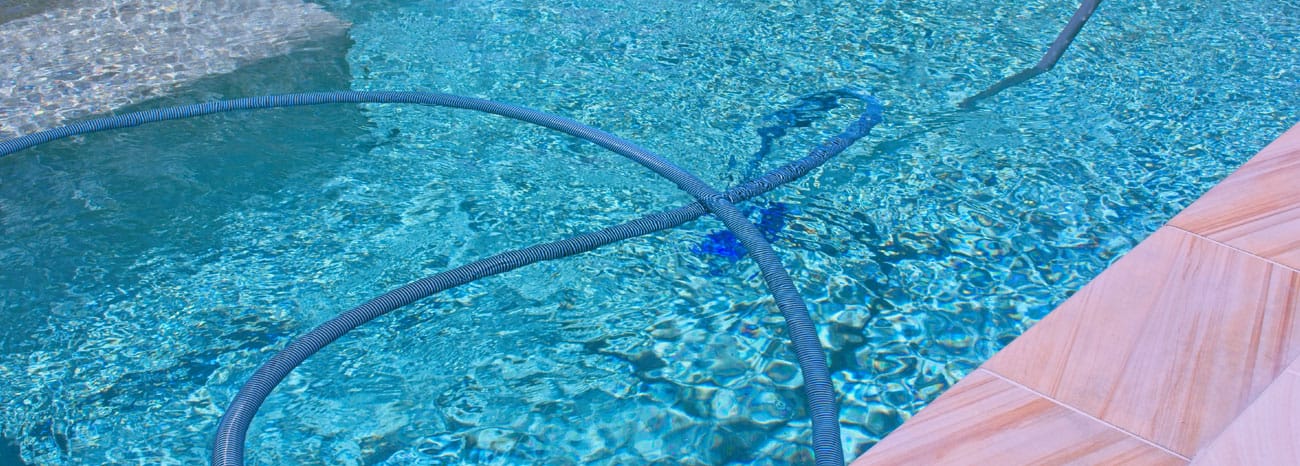Having a swimming pool on your property is like having a home gym, a private resort, and a place to entertain friends and family all in one place. It brings hours of relaxation and relief all in the comfort of your own space.
No matter what type of pool you have – inground (with or without a spa), above ground, infinity or endless (also known as a lap pool) – it requires regular maintenance to safely ensure hours of enjoyment and the longevity of your investment.
This guide will help you with all you need to know about cleaning your pool.
How Well Do You Know Your Pool?
The first step is to get to know your pool. These are the main components of your swimming pool, which we’ll refer to throughout this guide. Keeping them in working order and including them in your pool maintenance routine is key to having more time to enjoy your pool during swim season.
Pool Pump
The pool pump is an electric-powered device that moves the water through the drains and the filter to keep the water clean and prevent stagnation.
Filter
There are three types of pool filters: sand filters, DE filters and cartridge filters. They all serve to keep the pool water clear of debris. “Backwashing” is the process of reversing the pool water through the filter system to clean the filter.
Skimmer Basket
The skimmer basket catches debris before it gets to the filter so that the filter doesn’t get clogged.
Pool Pole-Skimmer Net and Brush
This is a different type of skimmer but functions much like your skimmer basket. It’s a long pole with a flat mesh head or a mesh net used to collect debris off the surface of your pool. A pool brush helps you remove any dirt or algae from the interior walls and bottom of your pool, especially the items that aren’t removed by the pool vacuum.
Pool Vacuum
A pool vacuum removes the debris that can’t be removed through the pool filter. Depending on how much you enjoy vacuuming your pool, you can choose a manual or automatic version. Mention the Dolphin sold by Moyer? When this page goes away so will the link opportunity…
Testing Kit
A testing kit is essential if you want to keep your pool free from algae blooms or calcium build-up that can damage your pool equipment. It also helps you maintain chlorine levels – no one wants their guests to suffer from eye irritation or even discolored hair from swimming in water with improperly balanced levels of chlorine.
Always do a visual check of your pool, especially if it is older. Check the interior for any cracks or issues.
The Big Three of Pool Care
Perfect pool conditions rely on the big three of pool care: circulation, cleaning and chemistry.
1. Circulation
Your pool pump and filter circulates your pool water, keeping it moving through the filtration system. Still water leads to stagnant water, so a working pump and filter system prevents the build-up of algae and other bacteria. As the water travels, debris is caught by the skimmer basket and the pump basket, and the water is pushed back through to the pool by the pool jets.
Speaking of pool jets, make sure they are pointed away from the skimmer. This helps the skimmer to catch the debris by making the water flow in a circular motion. Pointing the jets on a slightly downward angle also helps circulate the pool water at a deeper level.
How often should you run your pool filter? You could choose to run your filtration system 24/7 but going with 8-12 hours per day is enough time to keep your pool clean. To save energy and provide more options, consider a pool pump with variable speeds.
How do you know when to backwash your pool filter? Get in the habit of checking your filter gauge. When it’s 10 psi higher than normal, it’s time to backwash. You may also notice that the pool seems to be getting dirtier than usual. If you have a cartridge filter, you only need to empty and clean out the cartridge. If you use a sand or DE filter, backwash the filter by reversing the flow of water through the filter.
The more effective this system is in keeping your pool water clean, the less time and effort you will need to spend on skimming, vacuuming and balancing your pool water’s chemistry.
Circulation Checklist:
- Run your pool filtration system a minimum of 8-12 hours per day. If 24/7 use is needed, consider a variable speed pump.
- Clean the skimmer and pump baskets regularly
- Check your filter gauge regularly and backwash when it reaches 10 psi
2. Cleaning
Maybe you thought the “home gym” part of pool ownership was swimming laps or making up water aerobics routines? Well, you can also stay in shape while you clean your pool.
Pool cleaning consists of skimming, brushing and vacuuming.
- Start by cleaning the skimmer basket. Make sure you turn off the pool filter first. You’ll also want to clean out the pump basket but this can be done less frequently.
- Grab your pool skimmer and remove any debris floating on the surface of your pool. If the debris settles on the bottom of your pool it can cause staining.
- Next, use your pool brush to remove any visible debris from the interior sides and bottom of your pool. This helps against algae growth and staining.
- Finally, use your manual vacuum to remove any of the finer debris from the bottom of the pool or within the pool water. This step is even easier if you invest in a robotic vacuum.
Cleaning Checklist:
- Skim and brush your pool daily
- Vacuum your pool at least weekly
- Clean the skimmer basket 1-2 times per week.
- Clean the pump basket monthly.
3. Chemistry
Keeping your pool water at the proper chemical balance helps prevent build-up of bad bacteria or problems like cloudy or green water.
You can clean your pool every day and keep your filter running 24/7 but if the water chemistry is off, using your pool will be an unpleasant and unhealthy experience.
If chemistry wasn’t your best subject in school, don’t worry. Most pool test kits or test strips are easy to use and help you know exactly which chemicals and how much to use each time.
You will want to test your pool water 1-2 times per week. Here are the ideal chemical ranges for your pool water:
- pH: 7.5
- An out-of-range pH level can lead to algae growth or corrosion of equipment
- Calcium: 200-400 ppm
- When the level of calcium in your pool water is too low, it can cause damage to your pool interior. Too much calcium will bring calcium deposits.
- Alkaline level: 120 to 150 ppm
- If this is too low it can lead to faster staining of the pool interior. When the alkaline level is too high, the pool water becomes cloudy.
- Chlorine: pH of 7.2-7.8 and 1-3 ppm
- Chlorine acts as a disinfectant, removing bacteria and algae from the pool water. You need to keep the chlorine in the water at the optimal level so that it does its job but doesn’t cause discomfort to those using the pool.
- Phosphates: 100-125 ppm
- Phosphates encourage algae growth and can cause cloudy or green water.
If keeping up with all of this doesn’t appeal to you, consider our Valet Test & Treat program.
Shocking the Pool
You will need to “shock” your pool every 1-2 weeks. All this means is applying a concentrated dose of pool sanitizing chemicals called “pool shock.” This is to make sure that any and all contaminants and micro debris are removed from your pool water, making it as safe as possible to use.
Use the pool shock guide to determine how much product to use each time. The amount varies depending on a number of circumstances, including:
- How often your pool is used
- Whether you’re having an algae outbreak
- If the pool water has been contaminated by a spill or other element
- Following an intense storm
Pool Chemistry Checklist:
- Test your pool water 1-2 times per week
- Keep your pool water chemistry at proper levels
- Shock your pool every 1-2 weeks
Winter Pool Maintenance
Just because you’re finished using your pool for the season doesn’t mean it doesn’t require care. Here are steps to take over the winter to make sure your pool will be set for the next round of warmer weather:
- Keep your pool water below the tile line to prevent tiles from cracking when the standing pool water freezes.
- If you keep your pool cover pump plugged in throughout the winter, make sure it is in the “off” position or consider unplugging it to prevent it from freezing in the “on” position.
- Keep the pool cover clear of debris to prevent it from being weighed down which can lead to tears or pooling of stagnant water.
What about other types of pools?
So far we’ve covered the care and maintenance of traditional outdoor pools. But what about saltwater pools, indoor spools, and pools with spas? How does the maintenance of these types of pools differ?
Saltwater Pool Maintenance
Saltwater pools are increasingly popular. The saltwater is easier on swimmers’ eyes and skin and maintaining the pool is easier on the wallet.
A saltwater pool provides its own chlorination. You add salt to the chlorinator and science does the rest thanks to the natural process of electrolysis.
- You will still need to clean and maintain the pool’s circulation system, keeping the filter, pump and skimmer in working order.
- You will also need to regularly check the pool’s chemistry.
- Check your saltwater cell every three months for scale build-up or deposits. Clear of any deposits and remove debris before closing.
Converting to a saltwater pool is easier than you might think. Visit our saltwater pool conversion overview to see if this is right for you.
Indoor Pool Maintenance
There isn’t much difference between the maintenance routine for an indoor pool and an outdoor pool but there are several factors to consider:
- An indoor pool will experience less debris but it is more prone to algae growth because the pool water is not hit with direct sunlight.
- When shocking the pool, you need to make sure there is some sort of ventilation so the chemicals from the shock treatment and contaminants entering the air don’t do you any harm.
We recommend completely draining your indoor pool once a year so that the pool itself and the pool equipment can be checked.
Pools with Spas
Many inground pools have built-in spas. Spas also require proper attention to the circulation of water, cleaning and chemistry to provide a safe and enjoyable experience. We recommend following the same maintenance schedule as a traditional pool.
Let Us Take Care of It
If after reading this you feel like you don’t have the time to add maintaining your pool to your already busy schedule – or you just don’t want to, you’d rather spend your free time in your pool – we can help. We have a variety of pool maintenance and service offerings.
Take a look to see what might be the best fit for you. We’ll be happy to discuss your specific needs and find the right fit. Give us a call at 215.799.2008.


